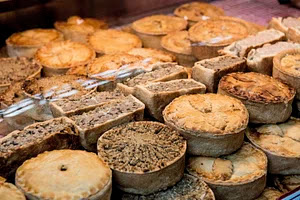Looking back at 16th century Yorkshire, pies were the common tradition. Rather than cakes, the Bride’s Pye (Bride’s Pie) was considered an essential dish for marriage celebrations. Like many wedding traditions its importance was tied to superstitions and thought to be necessary for the couple’s future happiness. Wait until you see what was expected of the bride in this tradition!
What bride’s pye symbolized
The bride and groom were presented with Bride’s Pye when they arrived at their new home. While this sounds like a nice way to welcome the couple to their new life together, in practice, the pie wasn’t only for eating. The bride only ate one piece and the rest was smashed over her head, and she wore the smashed pie for the rest of the day! Why? It symbolized her devotion to her husband.
Once the groom smashed the pie on his bride’s head, he threw the plate over his head and watched it break into pieces. The more pieces, the more years of happiness and fortune they could look forward to. Etiquette also required the bridegroom to wait on his bride.
And so, the bride’s pye was considered essential to the couple’s future happiness. This reminds me of the wedding tradition of the barley loaf which came before the bride’s pye. The loaf was broken over the bride’s head for good luck, and the people gathered crumbs for their own good fortune. In the case of the Bride’s Pye, it was considered rude if any attending the celebration didn’t take part.
How big was a bride’s pye?
A lot of work went into the making a bride’s pye. It was always round, with a thick decorated crust. Most often it was a mincemeat or mutton pie made with sweetbreads but I’ve also read a recipe that included a fat laying hen, full of eggs, probably intended as an emblem of fertility To get an idea of the size of this dish, consider this 1808 recipe from The experienced English Housekeeper by Elizabeth Raffaid.
- Boil two calf's feet, pick the meat from the bones and chop it very fine.
- Shred small one pound of beef suet and a pound of apples
- Wash and pick one pound of currants very small, dry them before the fire
- Stone and chop a quarter of a pound of jar raisins
- A quarter of an ounce of cinnamon
- A quarter of an ounce of mace or nutmeg
- Two ounces of candied citron
- Two ounces of candied lemon cut thin
- A glass of brandy and one of Champagne
Put them in a China dish with a rich puff paste over it, roll another lid, and cut it in leaves, flowers, figures, and put a glass ring in it.
Ring inside the pie
One last thing worth mentioning about the Bride’s Pye tradition is that it had a glass ring cooked into it. The lady who found the ring in her serving of pie was thought to be the next to marry.
The bride’s pye tradition carried into the seventeenth century but then evolved
into a bride cake, the precursor to the modern wedding cake. And while the smashing of the cake on the bride's head seems a strange tradition, when I think of how couples often smash wedding cake in each others' faces I guess our customs can be just as strange. I wonder if that's where smashing the cake originated.














